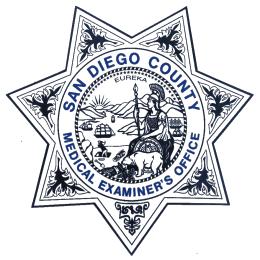 An external body examination of a decedent is essential at two stages in the forensic science process. The first time an external examination is carried out is upon discovery of a corpse. At this point the body should be checked for visible signs of injury and those injuries that are most likely to have caused subsequent death. At this stage both the medicolegal death investigator or coroner and authorized police personnel are present, and the body is checked over in what is known as a preliminary external examination.
An external body examination of a decedent is essential at two stages in the forensic science process. The first time an external examination is carried out is upon discovery of a corpse. At this point the body should be checked for visible signs of injury and those injuries that are most likely to have caused subsequent death. At this stage both the medicolegal death investigator or coroner and authorized police personnel are present, and the body is checked over in what is known as a preliminary external examination.
The medicolegal investigator should take careful photographs of the body and surrounding area – in particular wounds and defects located. These photographs should be taken with and without scale so as to identify the size and shape of the injuries while still at the scene and before the body has been moved. Clothing should also be examined for any signs of excreted bodily fluids and/or fibers.
Once the body has been removed from the scene and taken for pathological examination there is another external examination to be carried out before an autopsy can be completed.
Initial Observations
Initial findings of Livor Mortis, Rigor Mortis and Algor Mortis needs to be documented as well as any evidence of insect or animal degradation of the body. Summarize the initial observation of body; position, surface resting on, stage or presence of decomposition, and clothing. Not only what clothing is present, but how the clothing is arranged or worn. Could the clothing indicate redress or dragging?
Identification and Documentation
It is important that all wounds, defects, scars, tattoos, broken bones, or any other notable areas observed be well documented. Careful notes should be taken at the scene whether these are hand written or digitally recorded. This will aid in the proper summarization of the exam in your official case report. Refer to your agency’s policy concerning retaining or destroying notes or recordings.
A forensic body exam chart like the one you can find here: Male Female can be used to show areas of defects on the body. If using these charts be sure to indicate what your markings stand for in a key chart at the bottom of the page. Always indicate the head direction North and summarize this in your report. This will aid in recreation or explanation at a later time.
Use of Medical Terms
While it is vital that you properly identify areas of the body and refrain from using “unprofessional” terms, use of medical terms can be helpful. Keep in mind however that your report needs to be understand by everyone – from medical personnel to family of the deceased. Further caution when using terms is be sure that you are using the terms correctly and can explain terms when asked. Never use terms to sound knowledgable when you lack the education level to properly explain them.
Episode Guests
Julio Estrad a
a
Julio Estrada is the supervising investigator for the San Diego County Medical Examiners Office. Julio has 18 years experience as a death investigator, 14 as a supervisor. Previous experience as a emergency medical technician and 10 years as a physician in Mexico.
 Paul Parker
Paul Parker
Paul R. Parker III is a 26-year public sector professional. Paul has over 18 years of medicolegal death investigation experience, to include seven years in Chief Investigator roles at San Diego County (CA) and Maricopa County (Phoenix, AZ), two of the country’s largest Medical Examiner’s Offices (MEO), and the Director of the Pinal County Medical Examiner’s Office, a growing MEO between Phoenix and Tucson. Local and state agencies consult Paul on medicolegal death investigation issues, request guidance about preferred MEO operations and practices, and are recipients of his medicolegal education and outreach programs. Find out more at parkermls.com
Paul is a Registered Diplomate with the American Board of Medicolegal Death Investigators (D-ABMDI, #790) and has conducted in excess of 15,000 medicolegal death investigations and reviewed and approved reports and circumstances of an additional 20,000 medicolegal death investigations.
coroner,police training, darren dake,sheriff,deputy,coroner association,murder scenes,auto fatalities,csi,first responders,autoerotic fatalities,become a coroner,forensic science crime scene investigation,forensic science crime,scene investigator,forensic training,forensics training,how to be a crime scene investigator,how to become a death investigator,how to become a medical examiner,how to become a medical examiner investigator,medical examiner investigator training,medical investigator training,medicolegal death,medicolegal death investigator training,murder scenes,pictures of murder scenes,murder,real murder crime scenes,traffic deaths,traffic fatalities,what does it take to be a coroner,what does it take to be a criminal investigator,firefighter,fire training,firefighter training,autoerotic fatalities,become a coroner,coroner information,crime scene clean up training,crime scene cleaning training,crime scene cleanup training,crime scene investigation,crime scene investigation classes,crime scene investigator courses,crime scene investigator school,crime scene jobs,crime scene photography,crime scene photography training,crime scene technician,crime scene technician training,crime scene training,criminal investigation,criminal investigator,criminal justice,criminal justice forensic science,criminal justice forensics,criminal scene investigation,death crime scenes,death investigation training,death investigator training,death investigators,forensic death investigator,forensic investigator,forensic photography
3 comments on “External Body Exams on Scene – Medicolegal Investigation”
Leave a Reply
You must be logged in to post a comment.

Darren,
Hypothetically , if a gun falls out of the pocket of a decedent on the ME’s table, who was at fault? At what stage of the death investigation should the decedent had been searched? What about those at fault?
Thanks!
Great question Luis. I guess agency policy can vary, however the death investigator- whether it was a coroner, ME investigator or police – who last examined the body and was responsible for releasing the body for transport, would have been the last person responsible. But if that happens, and it has I promise you, you can be assured that NO ONE actually did a complete or through exam.
As for what might happen to those at fault. That depends on many issues and agency policy. I would guess that in most circumstances the ME would be calling a supervisor of the investigator then who knows. Light not be as ‘big a deal” as one might think. But it certainly could be. This would be kind of a case by case basis I’d say…
Darren